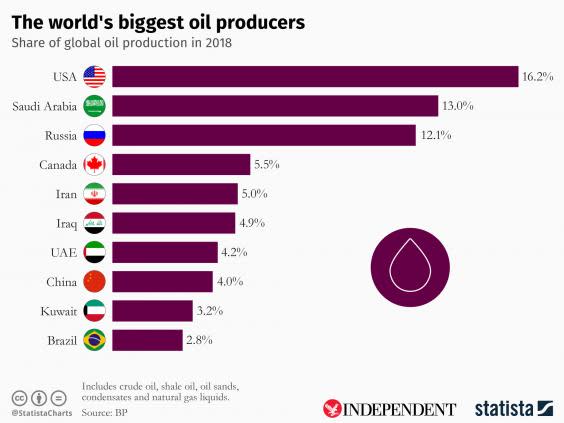Unprecedented drone attack on Saudi oil supply brings Middle East closer to brink of war

The Middle East moved closer towards a broad armed conflict on Monday following US accusations that Iran was behind a sophisticated multi-faceted attack on major Saudi oil facilities at the weekend.
President Donald Trump warned in a tweet late on Sunday that the US was “locked and loaded” in response to the Saturday morning attack, which took up to a half of Saudi oil production off line and caused world petroleum prices to jump 20 per cent.
But he also said that the US would wait for intelligence that confirmed the “culprit” behind the attack and until Saudi Arabia, whose leadership is closely allied with the Trump administration, provided guidance.
The attack on the world’s main supplier of oil rattled the world, drawing condemnations across geopolitical divisions. It comes amid a crisis prompted by the Trump administration’s withdrawal last year from the Iranian nuclear deal forged by his predecessor and the launch of a campaign of maximum pressure against Iran.
Mr Trump has vowed to punish any country or entity which buys oil from Iran, crippling the country’s economy. Iran has described the US policy as “economic terrorism” and vowed to retaliate.
Yemen’s Houthi rebels, which are closely allied with Iran and battling the Saudis for control of their country, have claimed responsibility for the attack, saying it was launched with drones and the assistance of friendly forces inside the kingdom.
But Secretary of State Mike Pompeo has cast doubt on that claim, and unnamed US officials have told Washington journalists that they suspected the attacks were launched from either Iraq or Iran using both drones and missiles.
"There's no doubt that Iran is responsible for this,” one US official was quoted as saying by Reuters. “No matter how you slice it, there's no escaping it. There's no other candidate. Evidence points in no other direction than that Iran was responsible for this.”
ABC News cited an unnamed US official as saying that Iran launched nearly a dozen cruise missiles and over 20 drones from its own territory in the attack, but provided no evidence substantiating the claim.
Late on Sunday, US vice president president Mike Pence and Defence Secretary Mike Esper were seen leaving the White House after a meeting with Mr Trump about the attack on Saudi facilities, prompting speculation that the military officials were drawing up targets. The US came close to attacking Iran in June, after Iranian forces downed an expensive American drone, but backed off at the last moment.

Saturday’s attack on the oil facility operated by Saudi Aramco was unprecedented in its accuracy and scale. Satellite photos released by the US showed meticulously punctured oil infrastructure at the Aramco site in eastern Saudi Arabia. Independent analysts have said the attack exceeds the range and capabilities of the Houthi rebels.
But Iran has strenuously denied it was behind the attack.
"Iran has explicitly declared its support for Yemeni people and their rights, but accusing Iran of such measures is in line with maximum deceit, and is totally baseless," foreign ministry spokesman Abbas Mousavi said on Monday.
Whether Iran or the Iranian-allied Houthis were behind the attack, the timing puts pressure on the US to either defend its staunch ally and risk a major confrontation with an unpredictable adversary, or refrain and risk looking weak, fraying trust in Washington by longtime partners.
The attack also dampens already dim prospects for a meeting between Mr Trump and Iranian president Hassan Rouhani at the UN General Assembly meeting this month, an encounter many European diplomats hoped would ease tensions and increase the prospect of scaling back Iran’s atomic research programme, which has been expanding since the US withdrew from the nuclear deal.
http://players.brightcove.net/624246174001/default_default/index.html?videoId=6086230836001
Drone attacks spark huge fire at Saudi Aramco, the world's biggest oil processing facility
Iran and the US have been at loggerheads since the 1979 revolution that toppled the pro-US monarch. Tehran’s clerical regime has said in recent years that if the US wants a shooting war, it is prepared for it, and has repeatedly shown a willingness to escalate rather than back down.
In an interview broadcast on Sunday, Iranian Revolutionary Guard commander Brig Gen Amir Ali Hajizadeh warned that the country was ready for armed conflict with the US.
"In addition to US bases, we have all of their vessels, including ships and warships within reach of our missiles at a distance of up to 2,000km, and we are constantly monitoring them,” he said.
"They think they will be safe if they get 400km away from us. But … as soon as a war breaks out, we will first put their vessels under fire."

